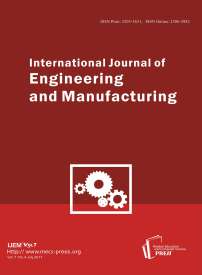Cover page and Table of Contents. vol. 7 No. 4, 2017, IJEM
Бесплатный доступ
ID: 15010026 Короткий адрес: https://sciup.org/15010026
Статьи выпуска 4, 2017 International Journal of Engineering and Manufacturing(IJEM)
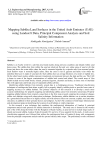
Статья научная
Sabkha is an Arabic word for a salt-flat area found mainly along arid area coastlines and inlands within sand dunes areas. The sabkha that form within the sand are relatively flat and very saline areas of sand or silt that forms just above the water-table where the sand is cemented together by evaporite salts from seasonal ponds. Such shallow water is normally highly saline. Here the crust is rich in gypsum and halite veins where the underline thin layer is made of sand and silt. Such sabkha have an average thickness of a meter or slightly less. On the other hand, marine sabkha represent transitional environments between the land and the sea. The UAE is home to some of the largest concentrations of sabkha both coastal and inland. The coastal areas of Abu Dhabi include several small shoals, islands, protected lagoons, channels and deltas, an inner zone of intertidal flats with algal mats and broad areas of supratidal sabkha salt flats. Identifying sabkha habitats from remotely sensed data is a challenging process. Traditional classification techniques of multispectral data alone, usually fail to properly identify sabkha pixels or provide lower rates of mapping accuracy for sabkha habitats. The primary objective of this research is to develop a much more accurate methodology for properly mapping and identifying sabkha areas from remotely sensed data. Properly mapping sabkha habitats from remotely sensed data is the first steps towards studying the ecological changes within such habitats using earth observation techniques. Furthermore, sabkha habitats can in certain situations be a geotechnical hazard due to its highly salinity and with adverse effects on concrete, asphalt, steel and other structures, in addition to their sporadic heaves and collapses. As the UAE continue to build major infrastructure and development projects identifying the location of such habitats is vitally important. In this research a new technique that combines the multispectral information of Landsat 8, principal component analysis and spectral soil salinity detection is developed. The study area is located in the western part of the UAE along the border with the Kingdom of Saudi Arabia, an area known to include large tracks of inland and coastal sabkha. Landsat 8 data from path 161 and row 43 was acquired for the study. A multi-source classification approach was followed that utilizes the multispectral data of Landsat 8 along with components from the principal components analysis and the spectral salinity index maps. The preliminary results confirmed by field observations show that the combined data improved the classification accuracy to almost 90% in comparison to multispectral data alone of 78%.
Бесплатно
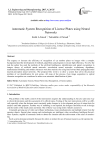
Automatic System Recognition of License Plates using Neural Networks
Статья научная
The urgency to increase the efficiency of recognition of car number plates on images with a complex background need the development of methods, algorithms and programs to ensure high efficiency, To solve the task the author has used the methods of the artificial Intelligence, identification and pattern recognition in images, theory of artificial neural networks, convolution neural networks, evolutionary algorithms, mathematical modeling and models characters were then statistics by using feed forward back propagated multi layered perception neural networks.. The proposed this work is to show a system that solves the practical problem of car identification for real scenes. All steps of the process, from image acquisition to optical character recognition are considered to achieve an automatic identification of plate.
Бесплатно
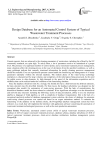
Design Database for an Automated Control System of Typical Wastewater Treatment Processes
Статья научная
Current requests, that are advanced to the cleaning parameters of wastewaters, including the offered by the EU community standards, are quite high. To satisfy them, a lot of parameters need to be maintained at a proper level. The presence of a significant number of control points, and a wastewater treatment process management, many situations affect the cleaning process in the case of deviations from the specified conditions, as well as many pollutants indicate that currently structured information for quality cleaning processes management should be available. Even an experienced operator cannot handle the monitoring and management of so many parameters optimally without the relevant database. The modern phase of the water-saving technology enterprises is characterized by large volumes and complexity of the information being processed, by the need for public access to data elements, by high demands to the speed of the information acquisition and its reliability that can be realized under the conditions of the functioning database. Since the database should not only be a storage, but should also have a link between the different elements, the data structure must be described formally. For that reason, the database subschema was designed (as the conceptual data model) for automation of water-saving processes. With the help of normalization, the hierarchical database model has been reduced to relational. It has significant advantages over the hierarchical and network data structures including the following: clarity of data presentation, ability to use one relational algebra (a language of Codd algebra), as well as simplicity of database reorganization. Due to the lack of a recognized analytical method of database management system selection, the choice of database for automatic water-saving control processes was carried out based on an expert estimations method. To maintain the functioning of the database on the defined criteria, the PostgreSQL database management system has been selected. As a result, that will implement the interface with application software concerning the automation of wastewater treatment technological processes, as well as the main production automation.
Бесплатно
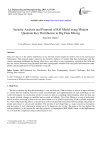
Статья научная
Data now days is of the utmost importance in our network system maybe be in Raw form or be it processed Information. This research paper represents the Security Analysis of modern Big Data technology with the various upcoming challenges and threats which has a vast effect on any organization working in this field and thus the various solutions using Quantum and other cryptographic methods with encryption and numerous other pitfalls and the applications of such methods in real life.
Бесплатно
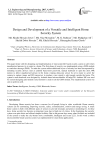
Design and Development of a Versatile and Intelligent Home Security System
Статья научная
This paper deals with the designing and implementation of microcontroller based security system to alert when unauthorized persons try to enter in a home. The first phase of security was implemented using a GSM module to send alert message (SMS). To make the system robust additional layers of security has been incorporated by including security devices such as android based door password, manual keyboard to open the door, PIR motion to detect unauthorized person in the home, rotating ultrasonic sensor by servo motor to active the camera to capture image and RF transceiver to produce voice signal to alert people outside the home. The system's main hardware was designed by Arduino based microcontroller ATmega328. Arduino ISP was used for system designing and Arduino serial monitor is used to test the GSM module. The implemented system was seen to perform well.
Бесплатно

